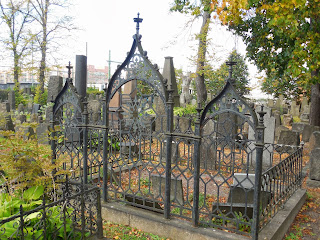This last week marked my one month anniversary in Gothenburg, Sweden. Every day continues to brings new surprises, but at last I am settling into life here in Sweden. It is fun now being able to speak a little Swedish, understand some of the signs that I see, and comfortably travel around the city. It has also been very rewarding interacting with so many Swedes, particularly the faculty and students at the University of Gothenburg's Department of Historical Studies. They have been most kind and generous in helping me learn about Swedish history.
It is funny how some things that were once so difficult are now quite manageable. For example, grocery shopping proved to be a real challenge early on, particularly trying to find different foods in the store and making sense of the labels. It is also like one endless math test where you divide the price in Swedish kronors by six to figure out if the price is somewhat reasonable (15 kronors for a bottle of water!). I'm also getting good at converting kilograms into pounds. I was particularly proud of myself recently for being able to track down all the ingredients to make American pancakes. By the way, they were delicious!
One of my goals for coming to Gothenburg is to explore Swedish approaches to public history. I really wanted to consider how the process of interpreting history in public is shaped by Sweden's culture, location, and sensibilities. As part of that effort, I'm studying the history museums of the Gothenburg region. In the process, I am rediscovering world history from a uniquely Swedish perspective. As a historian, it has been an amazing opportunity to reconsider my viewpoint and my assumptions about both American history and world history.
For example, last week I was invited by the Chamber of Commerce to visit the city's Emigranternas Hus museum, an institution dedicated to studying Swedish migration. The museum is housed in the original Customs House building along Gothenburg's harbor that served as the embarkation point for Swedish immigrants leaving for North America. Between 1850 and 1930, approximately 1 million Swedes, or almost one-third of the Swedish population, left the country for the United States. As Sweden's major international port, most Swedes leaving for America passed through Gothenburg and through the doors of the Customs House.
In both my United States history and World History courses, I have lessons on the history of immigration. However, it was eye opening to hear the story of immigration told from the European perspective. It was fun hearing the guide discuss a visit he took to Chicago's Andersonville to look for traces of Swedish culture. Our guide recounted finding many Swedish flags, a statue of a Darlana horse, and even a restaurant that sold Swedish meatballs. Additionally, a familiar story became new when our guide told the story of the sinking of the Titanic from the perspective of the ship's 123 Swedish passengers (89 of whom perished at sea).
Rather than just a museum, the Emigranternas Hus has a mission of encouraging conversation and research on the topic of immigration. Much like the United States, immigration is a sensitive political subject due to the large number of new immigrants entering the country. Many come from Eastern Europe, Africa, and the Middle East. The museum encouraged visitors to consider the history of Swedes as immigrants as a lens through which to better understand the experience of these men and women arriving in Sweden today.
I also gained a new appreciation of Cold War history by visiting the Aeroseum, a museum developed in a secret underground bunker used by the Royal Swedish Air Force starting in 1942, and that continued in use until the 1980s.
Originally designed to protect Swedish planes in case of an attack during World War II, the Swedish military expanded the site in the 1940s and 1950s to safeguard its aircraft in case of a nuclear confrontation between the U.S. and the U.S.S.R. The bunker of the Aeroseum offered a unique location to think about the repercussion of the Cold War even on a small, neutral nation like Sweden.
Perhaps most striking was a small exhibit discussing Sweden's efforts to develop its own atomic bomb:
I'm still not sure what the Swedes would have done with an atom bomb, but it certainly made me rethink the meaning of Swedish Cold War neutrality, and the lengths Swedes were willing to go to maintain their independence in a divided world. It is worth considering how even those nations that chose not to be part of NATO or the Soviet bloc still had their society's altered by the confrontation of the Cold War.
Last but not least, I visited the Nostalgicum, a museum dedicated to Swedish life in the 1950s and 1960s. My favorite room was one dedicated to Swedish hippies and the anti-war movement of the 1960s. The museum's labels told the story of growing Swedish protests against the American war in Vietnam, and the challenges those protests caused for the Swedish government. It is a story I have often told from an American perspective, but one that deserves to be told as a truly global story.
As a native of Woodstock, New York, I could not help smiling when I saw that the exhibit's section on hippies featured the classic red Woodstock Concert poster with the dove perched on a guitar. It made me proud as a Woodstocker, but it also made me wonder precisely what Woodstock meant to the Swedes--both then and today. When I teach United States history or World History next, I will certainly be asking my students to think about the events of the 1960s in a far more global perspective.
That's all for now. Next time I post, I will be sharing some of my research on Gothenburg's Old Jewish Cemetery. Until then, goodbye, or as they say in Sweden--hej då!






No comments:
Post a Comment